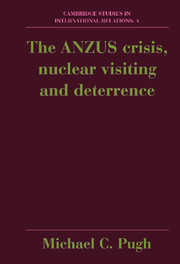Book contents
- Frontmatter
- Contents
- List of tables
- Preface
- List of abbreviations
- 1 INTRODUCTION: THE REVOLT OF AN UNDERLING
- 2 THE ANZUS TREATY AND STRATEGIC DEVELOPMENTS
- 3 DEFENCE CO-OPERATION AND NUCLEAR CONNECTIONS
- 4 WARSHIP ACCESS AND THE ANZAC LIABILITY SUSPENSIONS
- 5 NUCLEAR HAZARDS AND ENVIRONMENTAL SAFETY: ISSUES OF THE 1980S
- 6 ANTI-NUCLEAR POLITICS
- 7 FROM NEGOTIATION TO LEGISLATION
- 8 REGIONAL SECURITY AND THE FUTURE OF ANZUS
- 9 THE ANZUS CRISIS, NUCLEAR VISITING AND THE WESTERN ALLIANCE
- APPENDICES
- Notes
- Bibliography
- Index
2 - THE ANZUS TREATY AND STRATEGIC DEVELOPMENTS
Published online by Cambridge University Press: 06 July 2010
- Frontmatter
- Contents
- List of tables
- Preface
- List of abbreviations
- 1 INTRODUCTION: THE REVOLT OF AN UNDERLING
- 2 THE ANZUS TREATY AND STRATEGIC DEVELOPMENTS
- 3 DEFENCE CO-OPERATION AND NUCLEAR CONNECTIONS
- 4 WARSHIP ACCESS AND THE ANZAC LIABILITY SUSPENSIONS
- 5 NUCLEAR HAZARDS AND ENVIRONMENTAL SAFETY: ISSUES OF THE 1980S
- 6 ANTI-NUCLEAR POLITICS
- 7 FROM NEGOTIATION TO LEGISLATION
- 8 REGIONAL SECURITY AND THE FUTURE OF ANZUS
- 9 THE ANZUS CRISIS, NUCLEAR VISITING AND THE WESTERN ALLIANCE
- APPENDICES
- Notes
- Bibliography
- Index
Summary
Although security relationships are not defined merely by written commitments, the ANZUS Treaty is the formal basis of the alliance. The signatories referred to its terms in justifying their varying policies. Indeed, there is general agreement among scholars that the Treaty was a ‘bare and ambiguous framework’ which allowed flexibility in the safeguarding of national security claims and, of course, in the interpretation of obligations.
The first part of this chapter shows that, in addition to a common commitment to anti-communism, the parties brought distinctive perspectives to the 1951 negotiations, perspectives which, duly modified over time, were to influence their responses during the later crisis. The Treaty was a political statement rather than a legal document. Accordingly, the second part of the chapter examines the extent to which, by 1984, security concerns had shifted in scope and emphasis away from the original framework of consensus reflected in the Treaty, to the point where an apparently minor crisis could damage it irreparably.
But even as an instrument of publicly visible foreign policy, the trilateral relationship rarely needed to withstand major pressures until the Vietnam War. The parties had little call to develop management skills and appear to have banked on cohesion stemming from shared Western values, a common language, and overwhelming public disinterest in defence. Policy-making élites seem to have been ill prepared to cope with a gradual divergence in perceptions of the strategic role of the alliance.
- Type
- Chapter
- Information
- The ANZUS Crisis, Nuclear Visiting and Deterrence , pp. 18 - 39Publisher: Cambridge University PressPrint publication year: 1989



